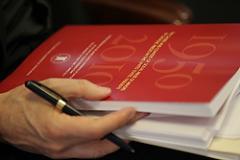By James Martin
America Magazine
June 21, 2011
http://www.americamagazine.org/blog/entry.cfm?blog_id=2&entry_id=4338
 |
Here is an important article to read (H/t to Dotcommonweal.). Karen J. Terry, the lead investigator for the John Jay College study on the "Causes and Contexts" of clerical sexual abuse in the church, responds to critics who faulted the conclusions of the study and the methods used to reach them. Professor Terry charges that the media coverage oversimplified the report's conclusions, that the "Blame the 1960s" summary was unfair, that the study was not influenced by the bishops, and that the report did in fact critique the bishops' record on abuse, contrary to some reports. Ms. Terry is also a professor in the Department of Criminal Justice at John Jay College, also serves as the college’s Associate Provost and Interim Dean of Research and Strategic Partnerships. Here she is summing up what the study did find:
The findings indicate that abusive behavior could best be explained through an interaction of micro- and macro-level factors. While the patterns of abuse in the Catholic Church are consistent with (though not causedby) patterns of other types of social behavior from the 1960s through the 1980s (when abuse cases peaked), data showed that most of the priest-abusers had problems such as intimacy deficits, an emotional and psycho-sexual maturity level similar to adolescents, and life stressors, as well as inadequate seminary education on how to live a life of chaste celibacy.
The abuse was particularly pronounced for men who were ordained in the 1940s and 1950s, a time when there was a substantial increase in Catholic seminarians and inadequate education for them.
These men were placed in positions where they were mentoring and nurturing adolescents and, like many non-clergy sex offenders, they regressed to abusive behavior.
Few abusers were primarily sexually attracted to children; a very small percentage of priests were clinically diagnosed with pedophilia (by clinicians, using standard guidelines of the Diagnostic and Statistical Manual of Mental Disorders). Many had other problems, such as alcoholism, stress, or financial improprieties.
And many priests who abused children also had sexual relationships with adults.
Taken together, this means that there is no risk assessment instrument that could have weeded out the abusers before ordination. This was a human problem; some adults are susceptible to abuse children in the Church and in any organization where adults spend time with children.
But the abusers themselves are only one part of the story. The Causes and Context report also chronicled in detail the Church’s response to abuse. The report states that the Church has taken significant steps in creating safe environments since signing the Charter for the Protection of Children and Young People in 2002.
The report also notes, however, that the implementation of child protection policies in the 1980s and 1990s was focused on priests instead of victims, was not consistent across dioceses in the United States, and lacked transparency.
Any original material on these pages is copyright © BishopAccountability.org 2004. Reproduce freely with attribution.